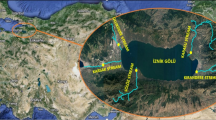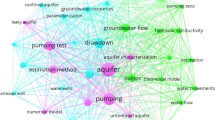Abstract
The genetic algorithm (GA) is a powerful method which can be used to solve search and optimization problems. A genetic algorithm with tournament selection, uniform crossover and uniform mutation is used to optimize sediment transport parameters in this study. Two important parameters of sediment transport, the critical shear stress for deposition and resuspension, are optimized by GA. The results show that GA is efficient and robust for optimizing parameters of our sediment transport simulation of Deep Bay.
Similar content being viewed by others
References
Ariathurai R, Krone R B. Finite element model for cohesive sediment transport [J]. Journal of Hydraulic Engineering Division, ASCE, 1976, 102: 323–338.
Cole P, Miles G V. Two-dimensional model of mud transport [J]. Journal of Hydraulic Engineering Division, ASCE, 1983, 109: 1–12.
Hayter E J, Mehta A J. Modelling cohesive sediment transport in estuarine waters [J]. Applied Mathematical modeling, 1986, 10: 294–303.
Van Rijn L C. Mathematical modeling for suspended sediment in nonuniform flows [J]. Journal of Hydraulic Engineering, ASCE, 1986, 112(6): 433–455.
Katopodi I, Ribberink J S. Quasi-3D modeling of suspended sediment transport by currents and waves [J]. Coastal Engineering, 1992, 18: 83–110.
Holland J H. Adaptation in Natural and Artificial Systems [M]. The University of Michigan Press, 1975.
Goldberg D E. Genetic Algorithms in Search Optimization and Machine Learning [M]. Addison-Wesley Publishing Company, 1989.
Michalewicz Z. Genetic Algorithms + Data Structures = Evolution Programs [M]. Springer-Verlag, 1999.
Wang Q J. The genetic algorithm and its application to calibrating conceptual rainfall-runoff models [J]. Water Resources Research, 1991, 27(9): 2467–2471.
Mohan S, Loucks D P. Genetic algorithms for estimat-ing estimating model parameters [J]. Integrated Water Resour. Plng. for the 21 st Century, Proc. of the 22 nd Annu. Conf., ASCE, 1995
McKinney D C, Min-Der Lin. Genetic algorithm solution of groundwater management models [J]. Water Resou. Res., 1994, 30(6): 1897–1906.
Vasques J A, Mailer H R, Lence B J, et al. Achieving water quality system reliability using genetic algorithms [J]. Journal of Environmental Engineering, 2000, 126(10): 954–962.
Mulligan A E. Genetic algorithms for calibrating water quality models. MS thesis, Medford, Department of Civil and Environmental engineering, Tufts University.
Cai X, Mckinney D C, Lasdon L S. Solving nonlinear water management models using a combined genetic algorithm and linear programming approach [J]. Adv Water Resour, 2001, 24(6): 667–676.
Khu S T, F di Pierro, Savic D, et al. Incorporating spatial and temporal information for urban drainage model calibration: An approach using preference ordering genetic algorithm [J]. Advances in Water Resource, 2006, 29: 1168–1181.
Holland J H. Concerning efficient adaptive systems Self-organizing Systems. edited by Yovits M.C., Jacohi G.T., Goldstein G.D. (Washington, DC: Spartan Books), 1962: 215–230.
Holland J H. Information processing in adaptive systems, Information Processing in the Nervous System [C]. Proceedings of the International Union of Physiological Sciences, 1962, 3: 330–339.
Holland J H. Some practical aspects of adaptive systems theory. Electronic Information Handling, edited by Kent, A., Taulhee, O.E. (Washington, DC: Spartan Books), 209–217.
Bagley J D. The behavior of adaptive systems which employ genetic and correlation algorithms. Ph. D. Thesis, Michigan, The University of Michigan, 1967.
De Jong K A. An analysis of the behavior of a class of genetic adaptive systems. Ph. D. Thesis, Michigan, The University of Michigan, 1975.
Krone R B. Flume studies of the transport of sediment in estuarial processes. Final Report. Rep. of Hydraulic Engineering Laboratory and Sanitary Engineering Research Laboratory, 1962, Berkeley, University of California
Lick W. Entrainment deposition and transport of fine-grained sediments in lakes [J]. Hydrobiologia, 1982, 91: 31–40.
Thorn M F C, Parsons J G. Properties of Grangemouth Mud [J]. Hydraulic Research Station Rep. No. EX 781, 1977, Wallingford UK.
Liu W C, Hsu M H, Kuo A Y. Modelling of hydrodynamics and cohesive sediment transport in Tashui River estuarine system, Taiwan [J]. Marine Pollution Bulletin, 2002, 44: 1076–1088.
Wu Y, Falconer R A, Uncles R J. Modelling of water flows and cohesive sediment fluxes in the Huber estuary, UK [J]. Marine Pollution Bulletin, 1998, 37(3–7): 182–189.
Muhlenbein H. Parallel genetic algorithms population genetics and combinatorial optimization [C]. Proceedings of the Third International Conference on Genetic Algorithms, 1989: 416–421.
Baker J E. Adaptive selection methods for genetic algorithms [C]. Proceedings of an International Conference on Genetic Algorithms and Their Applications, 1985: 100–111.
Suh J Y, Van Guncht D. Distributed genetic algorithms. (Technical Report No. 225), 1987, Bloomington: Indiana University, Computer Science Department.
Wardlaw R, Sharif M. Evaluation of genetic algorithms for optimal reservoir system operation [J]. Water Resour. Plan. Manage, 1999, 125(1): 25–33.
Soremekun G, Gurdal Z, Haftka R T, et al. Composite laminate design optimization be genetic algorithm with generalized elitist selection [J]. Comp Struct, 2001, 79: 131–143.
Spears W, DeJong K. On the virtues of parametrized uniform crossover [C]. Proceedings of the Fourth International Conference on Genetic Aogorithms, 1991.
Syswerda G. Uniform crossover in genetic algorithms [C]. Proceedings of the Third International Conference on Genetic Algorithms, 1989
Hu X J, Di Paolo E. An efficient genetic algorithm with uniform crossover for air traffic control [J]. Computers & Operations Research, 2009, 36: 245–259.
Author information
Authors and Affiliations
Corresponding author
Rights and permissions
About this article
Cite this article
Zhang, F.X., Wai, O.W.H. & Jiang, Y.W. Prediction of sediment transportation in deep bay (Hong Kong) using genetic algorithm. J Hydrodyn 22 (Suppl 1), 582–587 (2010). https://doi.org/10.1016/S1001-6058(09)60260-2
Published:
Issue Date:
DOI: https://doi.org/10.1016/S1001-6058(09)60260-2




